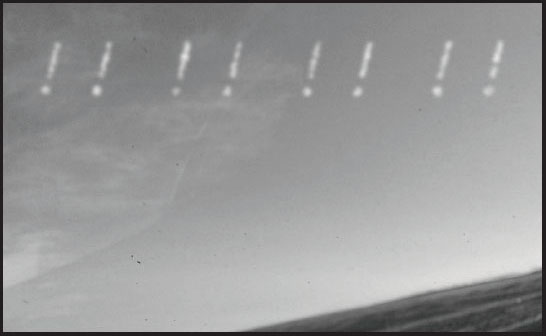
In October of 1921, nearly three years after the Armistice, Art Smith, The Bird Boy of Fort Wayne, sails to France to attend the selection of the American Unknown. On Sunday the 23rd, the ceremony is conducted at the Hotel de Ville in Châlons-sur-Marne with four caskets of unknown American soldiers disinterred from cemeteries at Aisne-Marne, Meuse-Argonne, Somme, and St. Mihiel converging on the city from four different directions. At that moment, Art Smith (flying a borrowed French SPAD VII specially modified to accommodate his aerial writing mechanism) applies the series (shown above) of evocative exclamations marks (designed to commemorate the moment of the cessation of hostilities and punctuate, in relative silence, the solemn proceedings going on below) in the sky over the city of Chalon-sur-Saône in Burgundy, an error (!) as the cities are often confused by those unfamiliar with the many Departments of France.
Chalon-sur-Saône, while not the actual venue for the selection of America’s Unknown Soldier, is thought to be the birthplace of photography, and its museum contains the Pyréolophore, the world’s first internal combustion engine. Art Smith, aloft, has no way of knowing that this history is preserved below while, he believes, another kind of history is being made. Now, nearly one hundred years after Nicéphore Niépce invented the technology of photography, Art Smith throttles up the Renault V8 powering his SPAD and turns toward Paris where, above the Eiffel Tower, he inscribes this curling cloud captured on film. He does so partly as an homage to Santos-Dumont’s feat of 1901, steering his Dirigible #6 around the structure to win the Deutsch Prize, but also as his tribute to the Unknown whose casket, draped in the Stars and Stripes and still sporting the dozen white roses Sergeant Edward Younger used to indicate his selection, is making its way to the capital city by dedicated train.
Captain Fred Zinn, a Michigander, who flew for the French Aéronautique Militaire and was the first to successfully deploy photographic combat reconnaissance from an airplane, introduces Art Smith to Gertrude Stein, the American expatriate art collector and author, that fall in Paris during the ceremonies surrounding the Unknown’s repatriation. At the writer’s atelier, 27 rue de Fleurus, Art Smith admires the walls of paintings he finds hanging there, noting how so many seem so flat to him, swaths of color similar to the way the land appears from the air, scored and divided into fields and pastures by roads and hedges. Captain Zinn then produces several prints of his wartime reconnoitering to confirm Smith’s insight, pointing out how the landscape grid had been disrupted by the asymmetry of the trench works, bombardment, and bastions. They talk of the theory of camouflage, of ground and foil, and the heroic convoy of Parisian taxicabs turning the Battle of the Marne. Miss Stein recalls watching the aerial dogfights in the late afternoons, the frenzied brushstrokes of smoke, the fiery streaks of fire. An observation balloon burning, its occupants buoyed by their tethered canopies of silk as they fell earthward. The disappearance of all birdlife from the campagne for seasons after the Armistice. She is, of course, intrigued with Smith’s skywriting, and the following day he demonstrates with this display over the Left Bank’s arrondissements, mapping in the air a woven net of clouds that seem, as the time passes and the exhausted smoke settles toward the ground, to expand and ensnare the whole city in a soft mesh of whitish ash.
At Le Havre, the cruiser USS Olympia departs for America with the casket of the Unknown. Art Smith circles the port in his SPAD, observing the ceremonies proceeding below. The French destroyers beyond the breakwater deliver a precise seventeen-gun salute that the Olympia, making way through the harbor, answers with its own salvo. The ship, escorted by a flotilla of torpedo boats, gathers steam. The crowds on the quay below disperse—the bands and battalions of soldiers, the school children and boy scouts, the fire brigade and gendarmerie. Lost in thought, he banks, a hard rudder, coming about one last time heading inland to land at Le Bourget Aerodrome. Behind him would be the Unknown on the voyage home and this periodic trail, like wreaths in the water, crumbs of clouds, an ellipsis, holding open a space, growing smaller in the distance, and falling, always falling, always falling short.